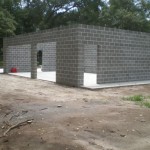How to Install Costco Garage Racks: A Comprehensive Guide
Maximizing storage space in a garage can be a crucial step in home organization. Costco's garage racks offer a robust and versatile solution for overhead storage, freeing up valuable floor space. This article provides a detailed guide on how to install Costco garage racks, ensuring a secure and functional storage system.
Before beginning the installation process, it is imperative to thoroughly review the manufacturer’s instructions included with the Costco garage rack system. This review encompasses understanding the components, specific safety guidelines, recommended tools, and any variations applicable to the particular rack model purchased. Divergences from the manufacturer's instructions can compromise the structural integrity of the installation and jeopardize safety. Ignoring the user manual may affect the product warranty.
Preparation and Safety Measures
Prior to any physical installation, meticulous planning is necessary. The first step involves identifying suitable mounting locations for the rack. These locations should ideally correspond with ceiling joists or studs, ensuring the rack's weight is evenly distributed and securely supported. Using a stud finder is essential for precisely locating these structural members. Avoid mounting the racks solely to drywall or plasterboard, as these materials lack the load-bearing capacity to support the weight of the rack and its contents.
Safety is of paramount importance during the installation process. Wearing appropriate personal protective equipment (PPE) is non-negotiable. This includes safety glasses to protect eyes from falling debris or airborne particles generated during drilling or fastening. Work gloves provide hand protection from sharp edges and potential injuries. A hard hat may be advisable, especially when working overhead, to protect against accidental impacts from tools or falling materials. Additionally, wearing sturdy, closed-toe shoes is crucial for foot protection.
Clearing the workspace is another vital preparatory step. Move any vehicles, tools, or other items from the area where the rack will be installed. This ensures ample room for movement and prevents accidental damage to property. A clear workspace also minimizes the risk of tripping or other hazards during the installation process. If possible, cover the floor with a drop cloth or protective sheeting to catch falling debris and facilitate cleanup.
Gathering the necessary tools is also essential before commencing the installation. A drill with various drill bits is required for creating pilot holes and securing fasteners. A socket wrench set will be needed for tightening bolts and nuts. A level is critical for ensuring the rack is installed horizontally, preventing uneven weight distribution and potential instability. A measuring tape will be necessary for accurately determining the placement and spacing of the mounting brackets. A ladder capable of reaching the ceiling safely is also indispensable. Additionally, a pencil or marker will be needed for marking locations for drilling and fastening.
Step-by-Step Installation Process
Once preparations are complete, the installation process can begin. This section details the sequential steps involved in assembling and mounting the Costco garage rack system.
The initial step involves assembling the rack frame according to the manufacturer's instructions. This typically involves connecting various metal components using bolts and nuts. Ensure all connections are securely tightened to provide a stable and rigid frame. Refer to the instruction manual for specific torque specifications for each fastener. If the rack includes adjustable components, ensure they are properly aligned and locked into place.
Next, locate the ceiling joists or studs using a stud finder. Mark the locations of these structural members with a pencil or marker. These marks will serve as guides for positioning the mounting brackets. Precise placement is crucial for ensuring the rack's weight is evenly distributed and securely supported. It may be necessary to adjust the position of the rack slightly to align with the joist locations. Avoid installing the rack if the joists or studs are significantly damaged or weakened.
Position the mounting brackets along the marked locations on the ceiling. Ensure the brackets are aligned and spaced according to the manufacturer's specifications. Using the brackets as a template, drill pilot holes into the joists or studs. The diameter of the pilot holes should correspond to the size of the lag bolts or screws used to secure the brackets. Drilling pilot holes prevents the wood from splitting and ensures a more secure connection.
Attach the mounting brackets to the ceiling joists or studs using lag bolts or screws. Use a socket wrench to securely tighten the fasteners. Ensure the brackets are firmly attached and that there is no play or movement. Overtightening the fasteners can strip the threads or damage the wood, while undertightening can compromise the stability of the installation.
With the mounting brackets securely in place, the assembled rack frame can be lifted into position. This step may require assistance from another person, especially for larger or heavier racks. Carefully align the rack frame with the mounting brackets and attach it using bolts and nuts. Ensure all connections are securely tightened. Double-check that the rack is level using a level tool. Adjust the mounting brackets if necessary to ensure a perfectly horizontal installation.
If the rack includes adjustable shelving or other accessories, install them according to the manufacturer's instructions. Ensure all components are securely attached and properly aligned. Check that the shelving is level and can support the intended weight. Avoid overloading the rack beyond its rated capacity, as this can compromise its stability and potentially lead to collapse.
Post-Installation Inspection and Weight Distribution
Upon completing the installation, a thorough inspection is essential to verify the stability and safety of the rack system.
Begin by visually inspecting all connections to ensure they are securely tightened. Check for any loose bolts, nuts, or screws. Inspect the mounting brackets for any signs of bending or stress. Ensure the rack frame is level and that there is no racking or swaying. If any issues are identified, address them immediately to prevent potential problems.
Test the stability of the rack by gently pushing and pulling on it. There should be minimal movement or deflection. If the rack feels unstable or wobbly, re-tighten the fasteners and re-evaluate the mounting brackets. It may be necessary to add additional support or reinforcement if the rack is subjected to heavy loads.
Proper weight distribution is critical for ensuring the longevity and safety of the rack system. Distribute the weight evenly across the entire rack surface. Avoid concentrating heavy items in one area, as this can overload the structure and potentially cause it to fail. Place heavier items closer to the mounting brackets for added support. Utilize the full capacity of the rack system, but never exceed the manufacturer's recommended weight limit. Clearly labeling the maximum weight capacity on the rack itself can serve as a reminder.
When loading items onto the rack, exercise caution to prevent damage to the rack or the stored items. Lift items carefully and avoid dropping or throwing them onto the rack. Use appropriate lifting techniques to prevent injuries. Arrange items neatly and securely to prevent them from falling off the rack. Consider using storage containers or bins to organize smaller items and prevent them from shifting during storage. Periodically inspect the rack for any signs of wear or damage, such as rust, cracks, or deformation. Address any issues promptly to maintain the structural integrity of the rack system.
After the rack is fully loaded, performing a final inspection is recommended. Re-check all connections, observe any unusual noises, and ensure the rack remains level and stable. If any issues are noted, remove the items and repeat the inspection process until the problem is resolved. Maintaining proper weight distribution and regular inspections will help to ensure the Costco garage rack system provides a secure and reliable storage solution for many years.
Saferacks 4 Ft X 8 Overhead Garage Storage Rack And Accessories Kit Costco
Saferacks 4 Ft X 8 Overhead Garage Storage Rack And Accessories Kit Costco
Saferacks Overhead Garage Storage Combo Kit Two 4 Ft X 8 Racks 18 Piece Deluxe Hook Accessory Pack Costco
Saferacks 4 Ft X 8 Overhead Garage Storage Rack And Accessories Kit Costco

Saferacks 4 Ft X 8 Overhead Garage Storage Rack And Accessories Kit Costco
Saferacks 2 Ft X 8 Overhead Garage Storage Rack And Accessories Kit Costco

Installing Costco 4x8 Saferacks For Overhead Garage Storage Save 700 Tax
Saferacks Garage Shelving Costco
Saferacks 4 Ft X 8 Overhead Garage Storage Rack And Accessories Kit Costco
Saferacks 4 Ft X 8 Overhead Garage Storage Rack And Accessories Kit Costco
Related Posts








